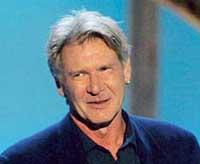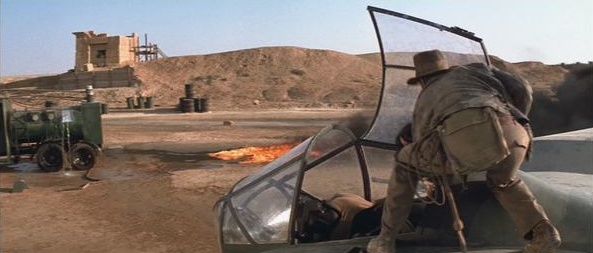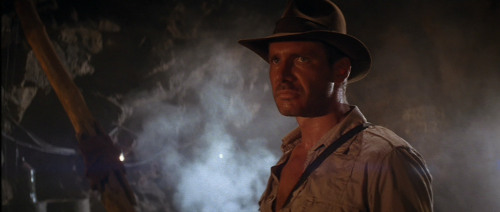Ain’t It Cool News are carrying a small item that links over to The Indy Experience, which in turn links to an interview with Kathleen Kennedy at Now Playing Magazine. Kennedy, for those who don’t recall, has been one of Steven Spielberg’s chief lieutenants (usually as producer) since as long ago as E.T., and she provides the latest, most reliable update on Indiana Jones IV, which is now to be set in the late 1940s:
“We’re working on a screenplay,” says Kennedy, long-time producing partner of Steven Spielberg. “I know this sounds like something that we’ve been saying for 15 years, but I’m hoping that we’re going to see something in a couple of months. Jeff Nathanson is working on the script right now… I will say this: If it comes in and we’re all happy with it, it will be more than likely the next thing we do.”
Kennedy acknowledges that previous reports of Nathanson’s script being “approved” by Indy producer George Lucas and director Spielberg were true, but that doesn’t quite mean what it sounds like it does.
“It’s one thing to approve something, it’s another thing to say it’s greenlit and we’re shooting it. So we’re just in that sort of phase of finessing,” she says, before responding to a question about whether or not star Harrison Ford is too old for the part these days. “No, I don’t think so. Certainly we’re not writing the script as though he’s 20 years old. You know, Sean Connery spent a lot of time in the Bond role and whatnot. I think it’s great that we can go make another Indiana Jones movie and Indy can be a little older. I think playing with that is a good thing.”
This is the rumour that simply doesn’t die: Indy IV has been speculated on by fanboys since before there were movie rumour webpages on which the speculating could occur. I’m an enormous fan of the series: the first two are amongst the greatest action/adventure films ever made, and the disappointing third film is still well above average for this kind of film. The Indiana Jones films are showcases for Spielberg’s immense talents as a director of action, and they feature a kind of action filmmaking that we don’t seem much these days: sequences based around rhythm, rather than speed. What I mean by that is that most action directors these days (Michael Bay and his ilk) base their action on sheer kineticism: the thrill is the rush of speed and movement. This is done not only through the all-pervasive fast cutting, but also with shaky camerawork, close shots, and by filling the frame with lots of very fast moving objects (such as cars, fighter jets or Jackie Chan). With a few exceptions (such as the rollercoaster minecar sequence in Temple of Doom) the Indy pictures don’t do this.
Instead, the action sequences in the Indiana Jones films are played out more like elaborate comedy routines, unfolding through complex progressions of cause and effect. To take an example from Raiders of the Lost Ark: Jones tries to get on a plane, so the pilot tries to shoot him, so Marion knocks him out, so the pilot slumps on the controls, so the plane rotates on the landing field, so the wing knocks a cap off the petrol tanker, so now the plane’s about to blow up…and so on. Spielberg stages and cuts these sequences in a manner that emphasies the way each event in the sequence falls into place. The cutting is generally not especially fast, and there are a lot of wider shots to setup the way parts of the space relate to each other. Other directors don’t often film their sequences like this, as pulling the camera back and using long shots makes it much harder to cheat the staging of a scene: if your shots are close and quick, you can put the elements together in the editing room. For example, have a look at this shot from the aforementioned sequence from Raiders of the Lost Ark:
Spielberg is staging a fairly complex piece of foreground action here: the plane is rotating, and Jones is busting Marion out of the cockpit. The “ticking clock” here – there is almost always a ticking clock of some sort in the Indiana Jones action sequences – is the flame in the background, which is running right to left towards the fuel tanker, after which it will run towards the plane and cause it to explode. (Adding to the complexity of the shot is the way that the moving flame is only just staying visible in front of the cockpit as it rotates.) Synchronising foreground and background action in this shot must have been hellishly complicated, and it would have been much simpler to just keep intercutting shots of the flames and the action on the plane, as occurs elsewhere in the sequence. But Spielberg understands the value gained from a moment like this: it reorientates the audience and makes the action either side of the side of the shot more intelligible and therefore more exciting. (In the DVD commentary for Return of the Jedi, George Lucas notes that the sail-barge sequence in that film tries to reproduce the effect of the Raider‘s flying wing sequence, but doesn’t manage to match it: Lucas is openly envious of Spielberg’s skill with setpieces like this, and rightly so.)
While most modern action films could benefit from more of these establishing shots, they are particularly crucial in the Indiana Jones movies. The action sequences in these films are like that old boardgame Mousetrap, with the ludicrously elaborate mechanism that triggers the trap through a complex chain reaction: the pleasure is in watching the way one thing leads to another. Shooting the sequences with clarity is therefore vital. This is also why the rhythm of the sequences is so important: they allow the cascading series of events to unfold in an almost musical way. (Even in a simple moment like the fistfight between Jones and the bald guy at the start of the flying wing sequence, note the way that they exchange punches in a deliberate, slow way that corresponds with the measured beats of the editing). In the under-appreciated Temple of Doom, Spielberg took this machine-like construction about as far as anyone ever has, setting up the temple as a giant playground of tunnels, walkways, flying foxes, pulleys, conveyer belts, ladders, waterwheels, and minecarts, and then linking his action sequences together so that the conclusion of one provides the setup for the next. Done well (and nobody does this kind of thing like Spielberg) these sequences are exhilarating in their sheer audacity.
Spielberg’s projects since haven’t really given him the chance to do this kind of thing: the action sequences in a film such as Minority Report are mere throwaways compared to the gigantic setpieces of the Indiana Jones films. So part of me would love to to see him return to the series. Spielberg’s form lately is much more solid than it was when he made Last Crusade: that film was made during an uncertain period in his career that saw such uneven-to-poor efforts as The Color Purple, Empire of the Sun, Always, and Hook, while Indy IV would follow a string of much better work that includes Minority Report, A.I., Catch Me if You Can, and War of the Worlds. Spielberg also seems to have more respect for 1980s techniques (shooting on film, physical effects) than George Lucas: one imagines he is less likely to go crazy with the computers than Lucas did on the Star Wars prequels, and is therefore more likely to get a result that feels like the originals.
But there are so many lingering doubts. While Last Crusade isn’t a particularly strong film, it is consciously constructed as the last film in the series, from the gratuitous “origin” prologue to its “ride into the sunset” finale. A new film made now, sixteen years later, would likely seem like an awkward coda, hanging off the end of the earlier films and diminishing them in much the same way The Godfather: Part Three sullies parts one and two. (I’ve always thought Back to the Future fans were foolish to hanker after a part IV of that series for the same reason). And there’s the issue of screenwriters. Various writers, including M. Night Shyamalan, Frank Darabont (who got his start on the Young Indiana Jones TV show) and Tom Stoppard (who was also rumoured to have contributed to Lucas’ Revenge of the Sith) have been connected with the project, but as noted above, it is currently in the hands of Jeff Nathanson. Nathanson has contributed to two of Spielberg’s recent films (Catch Me If You Can and The Terminal), but his resume also includes several fairly middling scripts such as the Rush Hour films and Speed 2: Cruise Control. He is a considerable step down from the screenwriters of the first two Indy films: Raiders was written by Lawrence Kasdan (who also co-wrote The Empire Strikes Back and Return of the Jedi) and Temple of Doom was written by Willard Huyck and Gloria Katz (who wrote American Graffiti and provided a crucial polish to Star Wars). Kasdan, Huyck and Katz were therefore instrumental in the early careers of Lucas and Spielberg: they were the screenwriters who mastered the tricky resuscitation of old serials that the directors were after in the Star Wars and Indiana Jones series. Today’s action films consistently struggle to match the finesse with which these screenplays achieved their goal, and it’s difficult to see Nathanson recapturing that magic.
And finally, there is the last point, which seems cruel to make, but which can’t be avoided: Harrison Ford. This is Harrison Ford in a screencap from Temple of Doom, when he was at his most physically imposing:
And this is Ford now:

I mean, I love Ford in this role, and the costume will no doubt help, but it’s still kind of hard to imagine, isn’t it?

